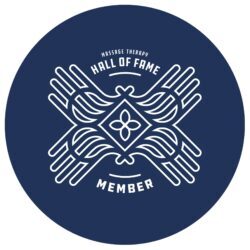I’ve been writing about the goings-on in the world of massage since 2007, reporting on what’s going on with regulations, the associations, scams and so forth, along with a healthy dose of my opinion about it. I’ve written somewhere in the vicinity of 300 blogs (my whole blogroll is on Massage Magazine’s website). I’ve slowed down lately. There are always things going on in the massage profession that are news-worthy, and I’m not hanging it up on the blog, but I am taking a little break.
Around the first of December, my husband, Champ, was diagnosed with Stage IV cancer in his tonsils and three lymph nodes on his neck. Our life was changed in the blink of an eye. I now think of it as BC (Before Cancer) and AC (After Cancer). Our life revolves around his treatment. He’s getting radiation 5 days a week (today ends week #3 out of 7 weeks the doctor has planned). Today he’s getting chemo #2 and the doctor has not yet made the final call on how many he’ll be receiving. Maybe as few as 4, or as many as 7. We’ll cross that bridge when we come to it.
Champ has a life-long platelet condition that complicates things. Most people have a platelet count of between 150,000-400,000. His are normally less that 20,000. They have been as low as 3,000. Right now, thanks to a platelet-building drug called Promacta, they’re up to about 40,000. Chemo knocks platelets down, so they’re monitoring his blood a couple of times a week to make sure he can withstand the chemo.
I’ve spent a lot of time on the phone with the insurance company. They want you to have pre-approval to sneeze. They want all referrals to come from the person they think it should come from. They want to get out of paying whenever possible. I’m not taking that lying down, and it’s time-consuming and stressful. Nothing, however, prepares you for the stress of seeing the love of your life sick with a life-threatening disease. I lie awake at night and worry. Then I’m tired during the daytime. I cry. I stress over things that are beyond my control, and I have frequent meltdowns. Our friends and family have rallied around and the emotional support is invaluable. It has spurred me to start hosting a Cancer Caregiver Support Group at my office, and to start a campaign to provide cancer caregivers with free massage.
Champ is getting the best of care. Janet Powell, Nurse Practitioner; Dr. Patric Ferguson, ENT; Dr. Zvonimir Milas, Surgeon; Dr. Mary Ann Knovich, Director of Blood Disorders at Levine Cancer Institute; Dr. Diego Pavone, Surgeon; Dr. Jeffrey Roberts, Oncology Radiologist, and Dr. Matt Rees, Oncologist/Hematologist, are all involved in his care. The nurses are wonderful. Everyone has moved as quickly as possible to take care of his needs.
So at the moment, my priority is seeing my husband get well. If something earth-shaking happens in massage-land, I usually mention that on my Facebook page, which you’re welcome to follow. We really appreciate all who have sent us messages, cards, called us on the phone, offered us food, financial help, prayers and well-wishes. Thank you all.
A lot of people have asked me if I have set up a gofundme page or something for Champ. I have not, and it isn’t that we don’t need help, but people were kind to us to donate to the silent auction that was held for me and send contributions to us last fall when I was the one who was sick, and I haven’t wanted to take advantage of people’s generosity.
Another thing has hit home to me since Champ has been sick, and that is the amount of stress that caregivers are under. Every morning when I go with Champ to his radiation treatments, I talk with the other caregivers who are in the waiting room. They are all in the same boat I am, trying to navigate the cancer maze, while dealing with fear, uncertainty, and the misery of seeing their loved ones sick. I want to offer them all a free massage, and I can’t. I am usually the receptionist/maid/laundry person at our office, and I have missed a lot of work and had to pay someone to do that while I go with Champ to all his appointments, and needless to say he cannot work right now, either. It has been a strain. So I have had the idea that instead of a gofundme, I would ask people to buy a gift certificate from our business for a cancer caregiver. The profit will help me pay for the people who are covering the office, and we’ll be able to provide some massage for people who need it. If you feel led to contribute to that, you can go to our online gift certificate. In the area that says recipient, put CANCER CAREGIVER and for the email address, put therassage@bellsouth.net. If you’re a local person, please consider giving a gift certificate to any cancer caregiver (or other caregiver) you might personally know. We appreciate the support, and we appreciate the emotional support. Thank you so much. https://thera.boomtime.com/lgift.
To those who are going through the same thing, don’t go through it alone. Join a support group–or start one. I’ve had to let go of some things. The world isn’t going to come to an end if my house isn’t clean, or if I don’t make it to the Chamber of Commerce meeting, or if the paperwork is piled higher than usual at the office. At the end of life, no one is going to wish they had spent more time cleaning or working. We will all wish that we had spent more time with our loved ones. That’s my priority.

